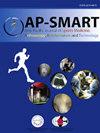Age-related changes in the quadriceps tendon: Collagen fibril diameter decreases with aging
IF 1.4
Q3 ORTHOPEDICS
Asia-Pacific Journal of Sport Medicine Arthroscopy Rehabilitation and Technology
Pub Date : 2025-07-01
DOI:10.1016/j.asmart.2025.06.002
引用次数: 0
Abstract
Background
The quadriceps tendon (QT) has recently gained attention as a graft tendon for anterior cruciate ligament (ACL) reconstruction due to its high strength from a larger ultrastructural collagen fibril diameter in children than that of the semitendinosus tendon. While QT collagen fibril diameter increases with growth, changes in older adults remain unclear. This study investigated age-related changes in QT collagen fibril diameter.
Methods
Twenty-four patients who had undergone ACL reconstruction using the QT or other knee surgeries were included. QT tissues collected during surgery were analyzed using transmission electron microscopy. Collagen fibril diameter was measured in four groups: Immature (11–13 years), Young (15–17 years), Adult (21–50 years), and Older (61–81 years). The average fibril diameter was calculated for each sample. At least four slides (one slide = one digital electron micrographs of the ultrathin section) were evaluated for each specimen, with at least 200 collagen fibrils on each slide. The average number of collagen fibrils measured per specimen was 812 ± 10. Data of the four groups were analyzed using one-way analysis of variance and Tukey's test.
Results
The mean collagen fibril diameters were 89.7 ± 14.4, 94.8 ± 16.4, 107.2 ± 12.1, and 73.0 ± 9.7 nm in the Immature, Young, Adult, and Older groups, respectively. Although no significant difference was observed between the Immature and Young groups, fibril diameter was significantly larger in the Adult group than in the Young group and significantly smaller in the Older group than in the other groups.
Conclusions
The average QT collagen fibril diameter increased with growth but was lower in the Older group, suggesting a decrease with aging.
与年龄相关的四头肌肌腱变化:胶原纤维直径随着年龄的增长而减少
背景近来,股四头肌肌腱(QT)作为前交叉韧带(ACL)重建的移植肌腱受到了关注,因为在儿童中,其超微结构胶原纤维直径比半腱肌腱大,强度高。虽然QT胶原原纤维直径随着生长而增加,但老年人的变化尚不清楚。本研究探讨QT胶原纤维直径的年龄相关性变化。方法选取24例采用QT或其他膝关节手术进行前交叉韧带重建的患者。术中收集的QT组织用透射电镜进行分析。测量胶原纤维直径分为四组:未成熟(11-13岁)、年轻(15-17岁)、成年(21-50岁)和老年(61-81岁)。计算每个样品的平均纤维直径。每个标本至少评估四张载玻片(一张载玻片=一张超薄切片的数码电子显微图),每张载玻片上至少有200个胶原原纤维。每个标本测得的平均胶原原纤维数为812±10。四组资料采用单因素方差分析和Tukey检验进行分析。结果未成熟组、青壮年组、成年组和老年组胶原原纤维平均直径分别为89.7±14.4 nm、94.8±16.4 nm、107.2±12.1 nm和73.0±9.7 nm。虽然未成熟组和幼龄组之间没有显著差异,但成虫组的纤维直径明显大于幼龄组,而幼龄组的纤维直径明显小于其他组。结论QT胶原纤维平均直径随年龄增长而增加,但在老年组呈下降趋势,提示QT胶原纤维平均直径随年龄增长而降低。
本文章由计算机程序翻译,如有差异,请以英文原文为准。
求助全文
约1分钟内获得全文
求助全文
来源期刊
CiteScore
3.80
自引率
0.00%
发文量
21
审稿时长
98 days
期刊介绍:
The Asia-Pacific Journal of Sports Medicine, Arthroscopy, Rehabilitation and Technology (AP-SMART) is the official peer-reviewed, open access journal of the Asia-Pacific Knee, Arthroscopy and Sports Medicine Society (APKASS) and the Japanese Orthopaedic Society of Knee, Arthroscopy and Sports Medicine (JOSKAS). It is published quarterly, in January, April, July and October, by Elsevier. The mission of AP-SMART is to inspire clinicians, practitioners, scientists and engineers to work towards a common goal to improve quality of life in the international community. The Journal publishes original research, reviews, editorials, perspectives, and letters to the Editor. Multidisciplinary research with collaboration amongst clinicians and scientists from different disciplines will be the trend in the coming decades. AP-SMART provides a platform for the exchange of new clinical and scientific information in the most precise and expeditious way to achieve timely dissemination of information and cross-fertilization of ideas.

 求助内容:
求助内容: 应助结果提醒方式:
应助结果提醒方式:


